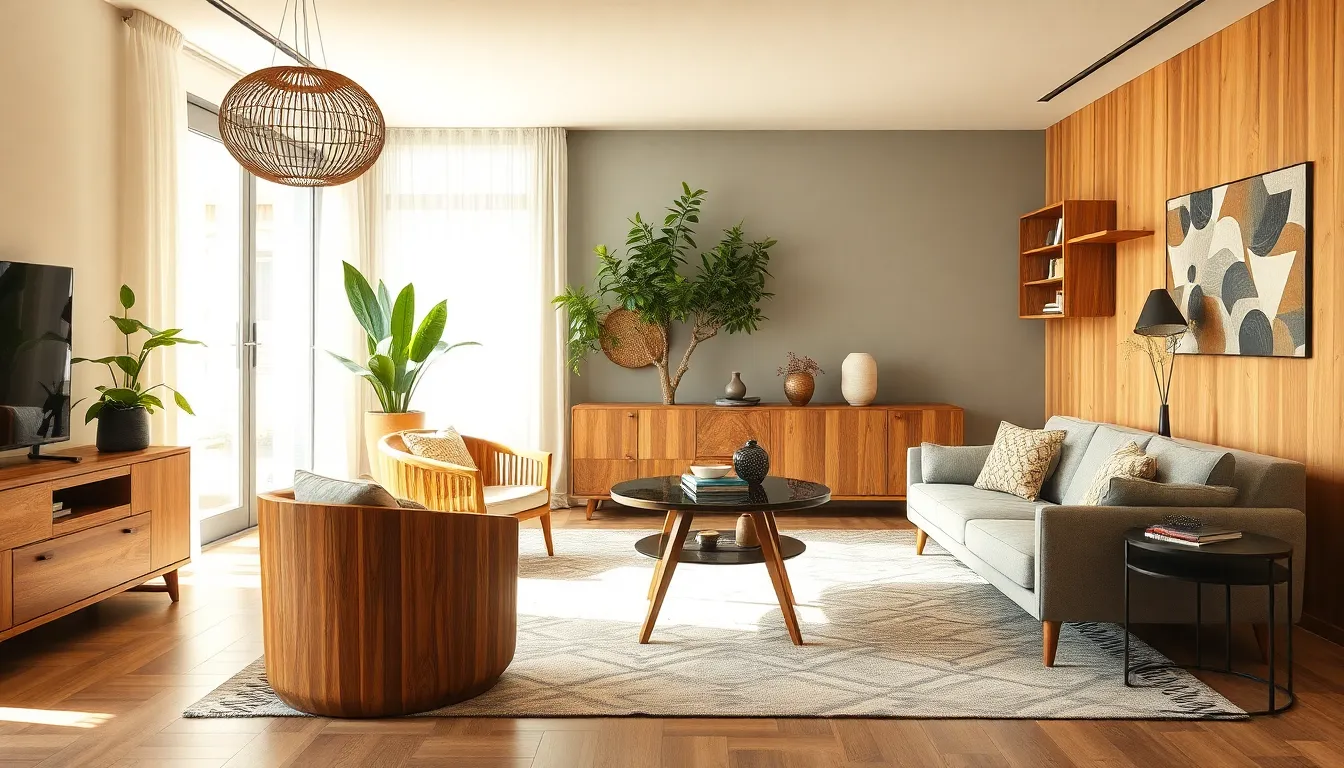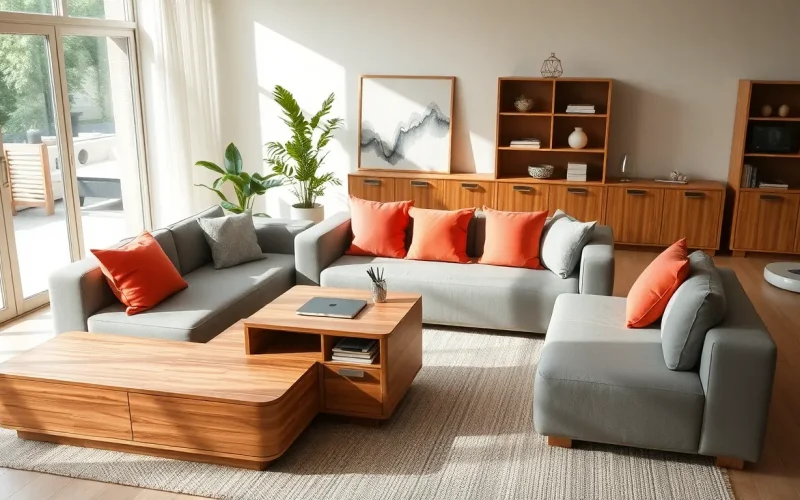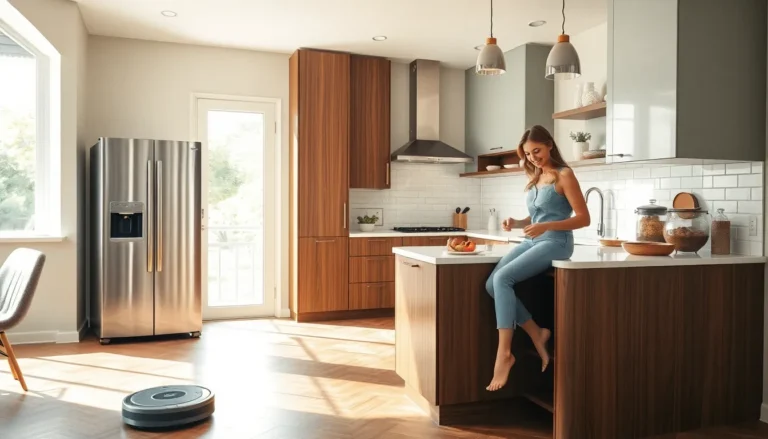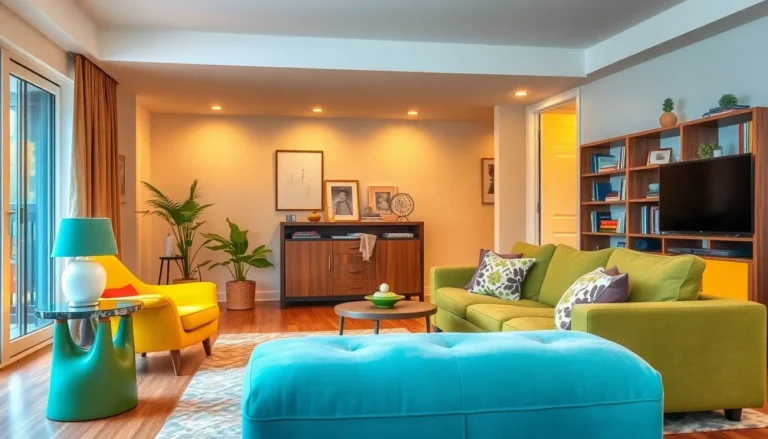Table of Contents
ToggleIn a world where furniture often plays the role of a wallflower, innovative designs are stepping into the spotlight and stealing the show. Gone are the days of bland, uninspired pieces that simply serve a purpose. Today’s furniture is all about creativity, functionality, and a sprinkle of whimsy. Imagine a coffee table that transforms into a cozy workspace or a sofa that doubles as a guest bed—welcome to the future of home decor!
As trends evolve, so do the needs of modern living. Innovative furniture caters to those who crave style without sacrificing practicality. It’s not just about aesthetics; it’s about maximizing space and making life a little easier. So, buckle up as we dive into the world of innovative furniture that’s not only smart but also guaranteed to make you smile. Who knew home furnishings could be this much fun?
Overview of Innovative Furniture
Innovative furniture redefines traditional concepts, combining style with functionality. Multifunctional pieces stand out in this modern trend, maximizing space and enhancing living environments. Consider a coffee table that easily transforms into a workspace, meeting diverse needs without sacrificing design.
Space-saving solutions address urban living challenges, offering options like foldable dining tables or wall-mounted desks. These designs create versatility, allowing homeowners to adapt areas as required. Furniture crafted with sustainable materials also gains traction, reflecting a growing eco-consciousness among consumers.
Smart technology integration enhances utility, with features like built-in charging ports or adjustable lighting. Creativity influences aesthetics, as designers experiment with unique shapes and vivid colors, bringing distinctive character to interiors. Versatility remains a key element; modular sofas enable easy reconfiguration to suit various layouts.
Personalization options abound, enabling consumers to choose finishes, fabrics, and patterns that align with their tastes. Enhanced comfort often accompanies these innovations, ensuring user satisfaction. In summary, innovative furniture represents a shift towards solutions that prioritize practicality, style, and sustainability, significantly impacting modern living environments.
Unique Materials Used in Innovative Furniture

Innovative furniture incorporates unique materials that enhance both aesthetic appeal and functionality. Notable options include eco-friendly and high-tech composites, which reflect modern consumer values.
Eco-Friendly Options
Sustainable materials gain traction in furniture design. Bamboo and recycled wood provide durability while minimizing environmental impact. Furniture made from these materials often features a contemporary look and required minimal processing. Natural textiles, such as organic cotton and hemp, enhance comfort and appeal to eco-conscious consumers. Reclaimed materials also play a significant role, allowing designers to create unique pieces with rich histories. Emphasizing sustainability attracts users who prioritize environmental efforts in their purchasing decisions.
High-Tech Composites
High-tech composites transform furniture into functional works of art. Designers employ materials like fiberglass and carbon fiber for lightweight yet robust structures. These composites provide versatility, allowing for innovative shapes and designs. Smart furniture integrating sensors and responsive technologies offers enhanced user experiences, making daily tasks easier and more efficient. Incorporating LED elements adds visual interest, merging functionality with style. As technology evolves, high-tech materials continue to redefine boundaries within furniture design and functionality.
Design Trends in Innovative Furniture
Innovative furniture design showcases various trends that address contemporary living needs. Two prominent trends include minimalist aesthetics and multifunctional designs.
Minimalist Aesthetics
Minimalist aesthetics focus on simplicity and clean lines. They embrace the idea that less is more, resulting in sleek, unobtrusive furniture pieces. Neutral color palettes, including whites, grays, and natural wood tones, dominate this approach. Open spaces benefit from these designs, allowing for a sense of tranquility and organization. Furniture pieces often incorporate geometric shapes that enhance visual appeal. This style encourages decluttering by emphasizing only essential furnishings, thus creating harmonious environments.
Multifunctional Designs
Multifunctional designs prioritize versatility in furniture pieces. They cater to diverse living spaces, often transforming from one form to another. For instance, a coffee table might convert into a workspace, meeting the needs of remote workers. Similarly, modular sofas adapt to various room layouts, ensuring optimal use of space. These designs alleviate challenges associated with urban living by maximizing functionality. Featuring hidden storage compartments further enhances practicality. Adaptable pieces contribute to efficient living, providing solutions for homes of all sizes.
Benefits of Innovative Furniture
Innovative furniture provides numerous advantages that transform living spaces into functional and stylish environments. These benefits include effective space optimization and enhanced comfort and functionality.
Space Optimization
Innovative furniture maximizes limited space through clever design solutions. Transformative pieces, like modular sofas, fit various room configurations and adjust to different layouts effortlessly. Foldable tables provide dining options without occupying excessive space, allowing users to easily store them when not in use. Wall-mounted shelves utilize vertical areas, contributing to a clutter-free atmosphere. By prioritizing multipurpose functionality, innovative furniture allows urban dwellers to make the most of their homes, creating a balance between style and utility.
Enhancing Comfort and Functionality
Comfort remains a key focus in innovative furniture design. Ergonomic chairs and adjustable desks promote proper posture and well-being during extended use. Soft, natural textiles contribute to a cozy environment while ensuring durability. Integrating smart technology simplifies daily tasks, as many pieces now feature built-in charging ports and customizable lighting options. Personalization opportunities let users tailor their furniture according to individual preferences, further enhancing the user experience. Ultimately, innovative furniture strikes a perfect balance between aesthetic appeal and practical functionality, making modern living more enjoyable.
Challenges in the Innovative Furniture Market
Innovative furniture faces several key challenges in today’s market. High production costs impact pricing strategies, limiting affordability for many consumers. Material sourcing poses difficulties, especially when striving for eco-friendly options. Supply chain disruptions can delay production and increase expenses, complicating the logistics for manufacturers.
Consumer acceptance presents another hurdle. Many individuals remain skeptical about new technologies, leading to slow adoption of smart furniture features. Preferences for traditional furniture styles may conflict with modern design innovations, creating resistance among certain demographics.
Additionally, competition intensifies within the industry. Numerous brands strive for market share while constantly introducing new designs and functions. Differentiation becomes essential, as companies must showcase unique selling points to capture consumer interest.
Sustainability trends also impact the market. Although many consumers prioritize eco-conscious choices, finding durable and aesthetically pleasing sustainable materials can be challenging. Balancing environmental responsibility with style requires innovative approaches in material selection.
Regulatory compliance poses another challenge. Furniture manufacturers must navigate various safety standards and certifications, making it essential to stay updated on relevant regulations. This complexity adds to the overall cost and time needed to bring products to market.
Lastly, rapid technological advancements require constant adaptation. Companies must invest in research and development to integrate the latest technologies. Keeping pace with changing consumer expectations also demands flexibility in design and functionality, complicating the innovation process.
Addressing these challenges affects how innovative furniture is perceived and utilized, shaping the future of the market.
Innovative furniture is reshaping the way people think about their living spaces. By blending style with practicality, it meets the demands of modern life while encouraging creativity in home design. As consumers increasingly seek multifunctional and sustainable options, the furniture industry is responding with exciting solutions that enhance both aesthetics and utility.
The integration of smart technology and unique materials opens up new possibilities for personalization and comfort. While challenges remain in terms of production and consumer acceptance, the potential for innovative furniture to transform environments is undeniable. Embracing these trends not only optimizes space but also elevates everyday living, making it an essential consideration for anyone looking to refresh their home.





